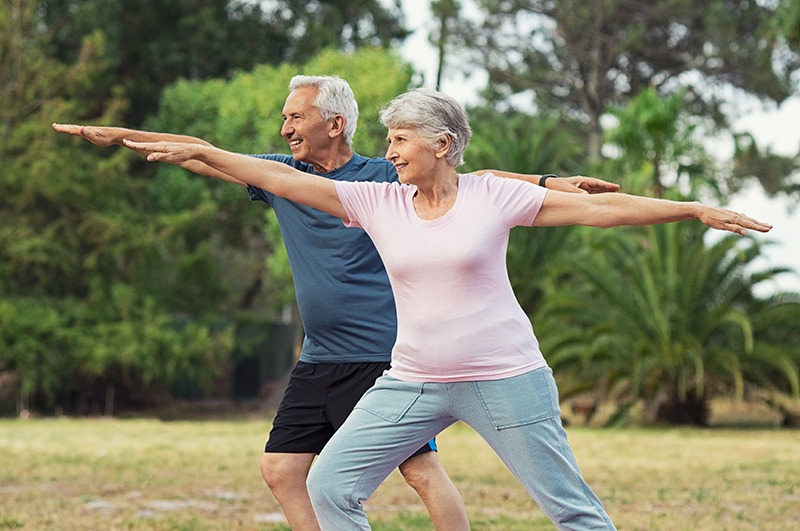
If you’re living with arthritis-related joint pain and stiffness, you know just how debilitating it can be. Luckily, regular exercise can ease your arthritis symptoms, keep you moving, and restore a better quality of life. Here’s how.
Arthritis is an umbrella medical term for more than 100 distinct conditions that cause joint inflammation, stiffness, and pain. In the United States, about 58.5 million adults — or nearly one in four Americans (23.7%) — have been diagnosed with arthritis. Over two in five adults (43.5%) with doctor-diagnosed arthritis find that persistent or severe symptoms restrict their mobility or limit their usual activities.
Arthritis-related joint pain and stiffness may have the power to transform the simplest task into a major challenge, but you have the power to hold it in check. How? By moving your body and engaging in smart daily exercise.
Read on as our seasoned team of board-certified experts at Orthopedic Center of Palm Beach County explains why exercise is essential when you have arthritis, and offers five joint-friendly workout options to help you get it.
Exercise is therapeutic for arthritic joints
It’s hard to truly appreciate how much you depend on healthy, pain-free joints until they’re undermined by arthritis. Arthritis-related inflammation, pain, and stiffness can make it harder to climb stairs, get in and out of a car, walk your energetic dog, or even open a jar.
While the nature and severity of arthritis symptoms can vary widely — among individuals as well as from one day to the next — stiff, achy joints are a top complaint. This motion-impairing pain is often limited to one or two joints, but can also be more widespread.
Inactivity aggravates arthritis
It’s tempting, and to a certain degree instinctive, to want to protect stiff, painful joints and avoid activities that you believe might cause further discomfort. But embracing a sedentary lifestyle only serves to decrease your strength and flexibility, reduce your range of motion, deplete your energy, and further hobble your mobility.
In fact, inactive arthritic joints are more likely to become increasingly stiff and painful, or even frozen, leading to the kind of restricted motion that interferes with daily life.
Movement keeps joints happy
Regular physical activity, on the other hand, takes stress off your joints by strengthening and toning the muscles and connective tissues that surround and support them. Exercise also fosters better joint lubrication and circulation, both of which help ease inflammation to take the edge off chronic arthritis pain and stiffness naturally.
Sticking with a consistent exercise routine has another key joint-saving benefit: It promotes a healthy body weight. Not having to support excess weight helps take unnecessary pressure off of all your joints, especially those in your lower back, hips, knees, ankles, and feet.
Joint-friendly workout recommendations
Once you’ve been cleared for exercise by your primary care provider, starting a low-impact fitness program is the best way to support and improve arthritic joints as you work to build stronger muscles, improve overall flexibility, and increase cardiovascular endurance.
Our top joint-friendly workout recommendations include:
Swimming and water aerobics
There’s no shortage of pools here in Palm Beach County, and that’s to your advantage when you’re working out with arthritis. Getting in the water is one of the best things you can do for stiff, achy joints.
Whether you swim laps, take water aerobics classes, or simply walk back and forth across the shallow end, water exercise provides buoyant resistance that allows you to strengthen, tone, and stretch your body without harming or overworking your joints.
Walking and hiking
Walking is a quintessential form of exercise for everyone, including people with arthritis. It doesn’t require training or a gym membership, and you can easily adjust your duration and intensity as your fitness level improves.
All you need is a pair of comfortable and supportive walking shoes and a place to walk. Start with a 30-minute walk each day — or two 15-minute walks — and advance when you’re ready to take on more. If you’re fairly fit, take your walk off-road and hike over a more varied terrain, or use a pair of trekking poles to give your upper body a workout at the same time.
Biking or indoor cycling
Cycling — whether it’s on a regular bike or a stationary indoor model — is an ideal low-impact aerobic workout that helps you burn calories without stressing your joints. In fact, cycling can help stabilize arthritic knee joints by strengthening your supporting leg muscles and promoting healthy joint lubrication.
Gentle stretching and yoga
Besides helping you warm up before physical activity and cool down afterward, stretching is an excellent way to decompress, soothe, and stabilize stiff, achy joints. Over time, flexibility training can even help you restore a fuller range of joint motion.
Whether you take gentle yoga classes or develop your own stretching practice, however, don’t push past your physical limits. Aim for comfortable stretches that don’t strain your muscles or stress your joints.
Ready to get active? Our experts can help
Are you ready to gain the upper hand over arthritis? Orthopedic Center of Palm Beach County can help you develop a joint-friendly exercise plan that eases your symptoms, keeps you active, and restores a better quality of life.
Call or click online today to schedule a visit at our location most convenient to you — Atlantis, Boynton Beach, or Wellington, Florida.





